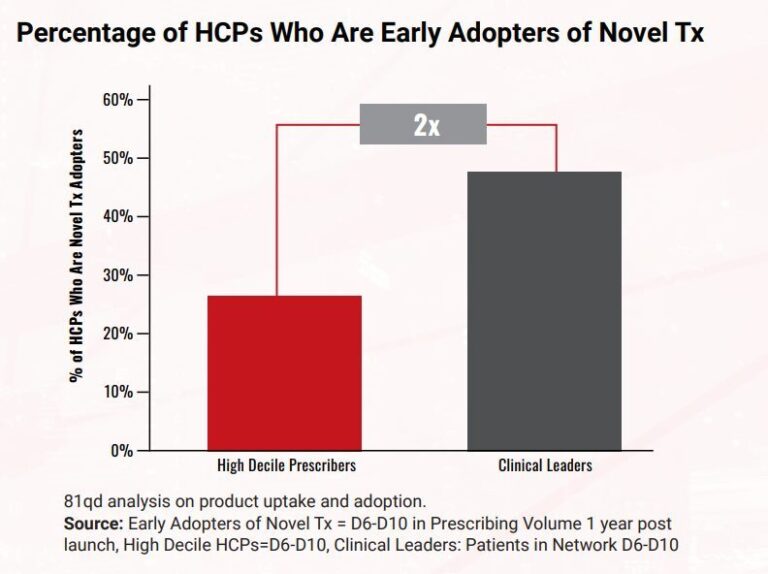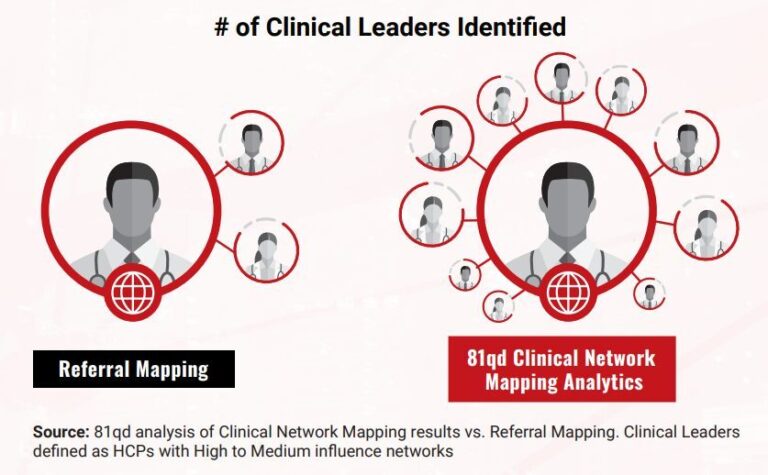Put the Competition in Check with TRUE Clinical Influencers
The Double Attack.
A double attack in chess is when you create multiple threats with one move. In today’s challenging HCP engagement and healthcare marketing/sales environment, field teams are searching for that double, triple, quadruple attack to win in their arena. Given limited access to HCPs, who should be prioritized for engagement that will broaden reach and impact?
Influence is the answer.
We have all experienced it. It may be a book we chose to read, a new series we binge-watch, a petition we sign, or the latest power washer of our dreams. Influence. Someone in our network has deemed something desirable, and we have been pulled along. This influence defines our choices and preferences. Clinicians experience this network influence as well, as they make choices and define their preferences. We define the most influential clinicians as Clinical Leaders, those who measurably impact the clinical behavior of other clinicians in their “clinical networks.” Identifying HCP influence, and especially these Clinical Leaders, can be complex but, once put in
position, enables the “double attack.”
Who Are These Clinical Leaders?
We identify Clinical Leaders through advanced artificial intelligence (AI)–driven analytics supported by anonymized patient-level claims. It is only through the use of these AI-based analytics that one can truly objectively and quantitatively identify these Clinical Leaders. It is through the power of AI that we can interrogate every single interaction the patient has during their treatment journey over the course of 3 years, irrespective of the specialty of the HCP they are seeing. By doing this, we analyze billions of data points to detect interpersonal connections among providers and thus can identify the most connected clinicians—the Clinical Leaders. Our analysis doesn’t stop there; we also map the clinical networks of these influential clinicians and measure the relative strength of the connections to other HCPs, thereby identifying which HCPs defer to specific Clinical Leaders for clinical decision-making.
High Volume Does Not Equal High Influence
Patient and prescribing volume is often a key driver of clinician prioritization. Patient and prescribing volume does not necessarily equate to clinical leadership. Clinical Leaders are not solely high-volume targets; they are the influencers of your targets. Clinical leadership can further refine prioritization by identifying those clinicians who influence others, thereby amplifying each sales rep detail, MSL discussion, or educational email directed at that Clinical Leader.
Clinical Leaders—The Most Connected HCPs
Generally, most HCPs will have some connections. The difference with Clinical Leaders is the size and reach of their networks. In one oncology analysis, we found that a target HCP had on average 33 connections to other targets, while a Clinical Leader had approximately 124 (or 4 times more) connections. By targeting these Clinical Leaders, you can activate their larger networks and broad influence to amplify your message, thus exploiting the double or even quintuple attack.
Clinical Leaders Influence Their Networks
We know that clinical decisions are driven by multiple factors—patient profile, insurance, regional dynamics, etc—so the question is, across all these varying factors, what percentage can be attributed to the impact of a Clinical Leader? To answer this question, we looked at 2 therapeutic areas: CNS and oncology. Within each area, we identified Clinical Leaders and mapped their clinical networks. We then assessed market share for a key product class within each therapeutic area, CGRPs for the CNS market and PD-(L)1s for the oncology market, and performed a regression analysis on market share for Clinical Leaders and the HCPs within their networks. For the CNS products, we found that up to 30% of the variance in the influencees’ average share was explained by the Clinical Leader’s share. The oncology market demonstrated similar results, with up to 29% of the variance in the influencees’ average share explained by the Clinical Leader’s share. Clinical Leaders increase the product adoption of their networks exponentially.
Clinical Leaders Drive Adoption
How do Clinical Leaders prescribe? Clinical leaders do not solely influence others, Clinical Leaders were twice as likely to adopt new products compared with other HCPs. In order to take a data-driven approach, we retrospectively examined the prescribing behaviors for High Rx Decile HCPs vs Clinical Leaders 1 year after the launch of a novel biologic therapy. The results indicated that Clinical Leaders were twice as likely to be early adopters of this novel therapy vs High Rx Decile HCPs. Given their influence on prescribing, this highlights the importance of Clinical Leader identification to drive adoption of innovation and provides even further support for the “Double Attack.”

Not Your Grandfather’s Referral Mapping
Identifying Clinical Leaders may sound like referral mapping—it is not. Clinical network mapping can identify 5 times more connections than standard referral mapping analytics. Relying on referrals alone provides a limited data set because most claims do not contain referrals. Clinical network mapping leverages a broader data set and does more with it. Clinical network mapping goes beyond just referrals and uses AI to assess multiple types of data points, including treatment history, patient demographic information, specialty, health plan/insurance data, shared patients, and changes in HCP behaviors to assess influence and build networks. The use of all available data points within a claims data set vs the limited amount of data commonly used in referral analyses allows for much more nuanced and bidirectional clinical network analysis.

AI-Driven High Impact Targeting and Marketing Enabled
In a world where field-HCP interactions have fallen by an average of 65%, 1 engagement with the highest impact HCPs will be critical to drive brand growth. The applications of a Clinical Leader analysis are numerous and span marketing, field, digital, and medical. Examples include:
- Building more efficient and effective engagement plans
- Identifying the right targets for MSLs or thought leader liaisons
- Refining field and digital target lists
- Optimizing peer-to-peer and NPP programs by directly supporting speaker selection and NPP dissemination
- Indirectly engaging with “no-see” HCPs by meeting with the Clinical Leaders who influence
Each engaged Clinical Leader translates into downstream engagement with their networks. If you are not identifying and leveraging Clinical Leaders in your HCP targeting and engagement strategy, you are missing a critical lever. You are missing the opportunity to exploit the “double attack.




